SECRETS OF CHESS
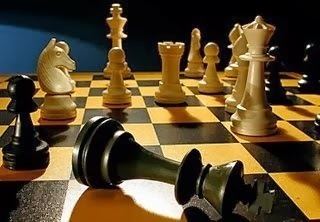
Chess is a two-player strategy board game played on a chessboard, a checkered gameboard with 64 squares arranged in an eight-by-eight grid. It is one of the worlds most popular games, played by millions of people worldwide in homes, parks, clubs, online, by correspondence, and in tournaments.
Each player begins the game with 16 pieces: one king, one queen, two rooks, two knights, two bishops, and eight pawns. Each of the six piece types moves differently. Pieces are used to attack and capture the opponents pieces, with the objective to checkmate the opponents king by placing it under an inescapable threat of capture. In addition to checkmate, the game can be won by the voluntary resignation of the opponent, which typically occurs when too much material is lost, or if checkmate appears unavoidable. A game may also result in a draw in several ways, where neither player wins. The course of the game is divided into three phases: opening, middlegame, and endgame.
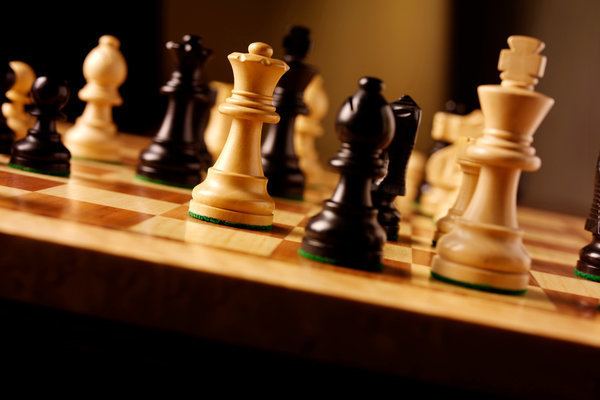
The first official World Chess Champion, Wilhelm Steinitz, claimed his title in 1886; the current World Champion is Norwegian chess Grandmaster Magnus Carlsen. In addition to the World Championship, there are the Womens World Championship, the Junior World Championship, the World Senior Championship, the Correspondence Chess World Championship, the World Computer Chess Championship, and Blitz and Rapid World Championships. The Chess Olympiad is a popular competition among teams from different nations. Online chess has opened amateur and professional competition to a wide and varied group of players. Chess is a recognized sport of the International Olympic Committee and international chess competition is sanctioned by the World Chess Federation (FIDE), which adopted the now-standard Staunton chess set in 1924 for use in all official games. There are also many chess variants, with different rules, different pieces, and different boards.
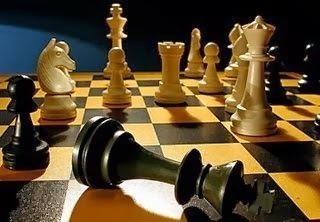
Since the second half of the 20th century, computers have been programmed to play chess with increasing success, to the point where the strongest home computers play chess at a higher level than the best human players. In the past two decades computer analysis has contributed significantly to chess theory, particularly in the endgame. The computer Deep Blue was the first machine to overcome a reigning World Chess Champion in a match when it defeated Garry Kasparov in 1997.
| Years active | c. 6th-century India to present |
|---|---|
| Genre(s) | Board game Abstract strategy game |
| Players | 2 |
| Setup time | c. 1 minute |
| Playing time | Casual games usually last 10 to 60 minutes; tournament games last anywhere from about ten minutes (blitz chess) to six hours or more. |
| Random chance | None |
| Skill(s) required | Strategy, tactics |
Rules
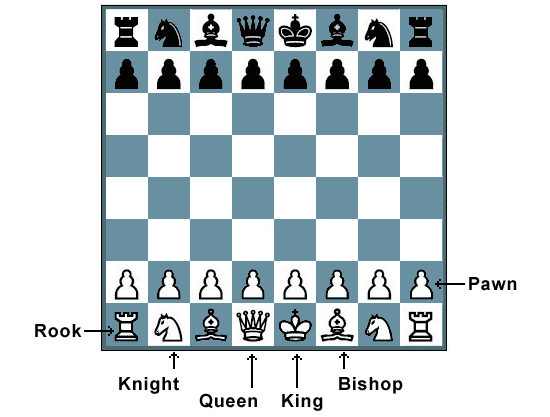
The official rules of chess are maintained by the World Chess Federation. Along with information on official chess tournaments, the rules are described in the FIDE Handbook, Laws of Chess section.
Setup :
Chess is played on a square board of eight rows (called ranks and denoted with numbers 1 to 8) and eight columns (called files and denoted with letters a to h) of squares. The colors of the 64 squares alternate and are referred to as "light" and "dark" squares. The chessboard is placed with a light square at the right-hand end of the rank nearest to each player, and the pieces are set out as shown in the diagram and photo, with each queen on a square of its own color.
The pieces are divided, by convention, into white and black sets. The players are referred to as "White" and "Black", and each begins the game with 16 pieces of the specified color. These consist of one king, one queen, two rooks, two bishops, two knights, and eight pawns.
Movement
White always moves first. After the first move, players alternately move one piece per turn (except for castling, when two pieces are moved). Pieces are moved to either an unoccupied square or one occupied by an opponents piece, which is captured and removed from play. With the sole exception of en passant, all pieces capture opponents pieces by moving to the square that the opponents piece occupies. A player may not make any move that would put or leave his or her king under attack. If the player to move has no legal moves, the game is over; it is either a checkmate (a loss for the player with no legal moves) if the king is under attack, or a stalemate (a draw) if the king is not.
Each chess piece has its own style of moving. In the diagrams, the dots mark the squares where the piece can move if no other pieces (including ones own piece) are on the squares between the pieces initial position and its destination.
The rook can move any number of squares along any rank or file, but may not leap over other pieces. Along with the king, the rook is involved during the kings castling move.
The bishop can move any number of squares diagonally, but may not leap over other pieces.
The queen combines the power of the rook and bishop and can move any number of squares along rank, file, or diagonal, but it may not leap over other pieces.
The knight moves to any of the closest squares that are not on the same rank, file, or diagonal, thus the move forms an "L"-shape: two squares vertically and one square horizontally, or two squares horizontally and one square vertically. The knight is the only piece that can leap over other pieces.
The pawn may move forward to the unoccupied square immediately in front of it on the same file, or on its first move it may advance two squares along the same file provided both squares are unoccupied (black "?"s in the diagram); or the pawn may capture an opponents piece on a square diagonally in front of it on an adjacent file, by moving to that square (black "x"s). The pawn has two special moves: the en passant capture and pawn promotion.
Castling
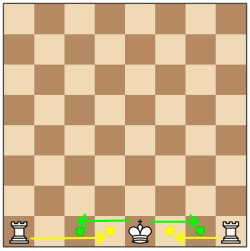
Once in every game, each king is allowed to make a special move, known as castling. Castling consists of moving the king two squares along the first rank toward a rook (which is on the players first rank[note 1]) and then placing the rook on the last square the king has just crossed. Castling is permissible only if all the following conditions hold:[2]
Neither of the pieces involved in castling may have been previously moved during the game.
There must be no pieces between the king and the rook.
The king may not be in check, nor may the king pass through squares that are under attack by enemy pieces, nor move to a square where it is in check.
En passant
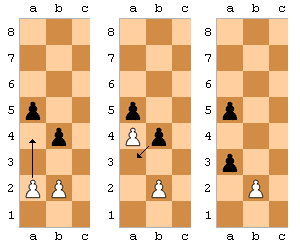
When a pawn advances two squares from its starting position and there is an opponents pawn on an adjacent file next to its destination square, then the opponents pawn can capture it en passant (in passing), and move to the square the pawn passed over. However, this can only be done on the very next move, otherwise the right to do so is forfeit. For example, if the black pawn has just advanced two squares from g7 (initial starting position) to g5, then the white pawn on f5 may take it via en passant on g6 (but only on whites next move).
Promotion
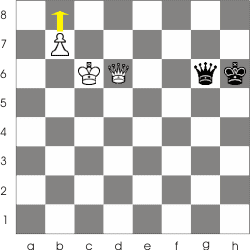
When a pawn advances to the eighth rank, as a part of the move it is promoted and must be exchanged for the players choice of queen, rook, bishop, or knight of the same color. Usually, the pawn is chosen to be promoted to a queen, but in some cases another piece is chosen; this is called underpromotion. In the diagram on the right, the pawn on c7 can be advanced to the eighth rank and be promoted to an allowed piece. There is no restriction placed on the piece that is chosen on promotion, so it is possible to have more pieces of the same type than at the start of the game (for example, two queens).
Check
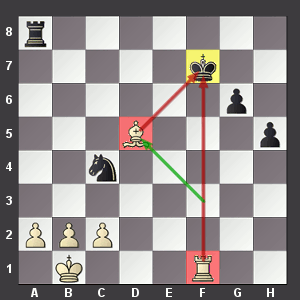
When a king is under immediate attack by one or two of the opponents pieces, it is said to be in check. A response to a check is a legal move if it results in a position where the king is no longer under direct attack (that is, not in check). This can involve capturing the checking piece; interposing a piece between the checking piece and the king (which is possible only if the attacking piece is a queen, rook, or bishop and there is a square between it and the king); or moving the king to a square where it is not under attack. Castling is not a permissible response to a check. The object of the game is to checkmate the opponent; this occurs when the opponents king is in check, and there is no legal way to remove it from attack. It is illegal for a player to make a move that would put or leave his own king in check.
End of the game
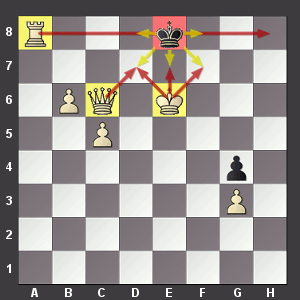
Although the objective of the game is to checkmate the opponent, chess games do not have to end in checkmate—either player may resign which is a win for the other player. It is considered bad etiquette to continue playing when in a truly hopeless position. If it is a game with time control, a player may run out of time and lose, even with a much superior position. Games also may end in a draw (tie). A draw can occur in several situations, including draw by agreement, stalemate, threefold repetition of a position, the fifty-move rule, or a draw by impossibility of checkmate (usually because of insufficient material to checkmate). As checkmate from some positions cannot be forced in fewer than 50 moves (such as in the pawnless chess endgame and two knights endgame), the fifty-move rule is not applied everywhere, particularly in correspondence chess.
Time control
Chess games may also be played with a time control, mostly by club and professional players. If a players time runs out before the game is completed, the game is automatically lost (provided his opponent has enough pieces left to deliver checkmate). The duration of a game ranges from long games played up to seven hours to shorter rapid chess games, usually lasting 30 minutes or one hour per game. Even shorter is blitz chess, with a time control of three to 15 minutes for each player, and bullet chess (under three minutes). In tournament play, time is controlled using a game clock that has two displays, one for each players remaining time.
Strategy and tactics
Chess strategy consists of setting and achieving long-term positioning advantages during the game – for example, where to place different pieces – while tactics concentrate on immediate maneuver. These two parts of the chess-playing process cannot be completely separated, because strategic goals are mostly achieved through tactics, while the tactical opportunities are based on the previous strategy of play. A game of chess is normally divided into three phases: opening, typically the first 10 moves, when players move their pieces to useful positions for the coming battle; then middlegame; and last the endgame, when most of the pieces are gone, kings typically take a more active part in the struggle, and pawn promotion is often decisive.
Fundamentals of tactics
In chess, tactics in general concentrate on short-term actions – so short-term that they can be calculated in advance by a human player or by a computer. The possible depth of calculation depends on the players ability. In quiet positions with many possibilities on both sides, a deep calculation is more difficult and may not be practical, while in "tactical" positions with a limited number of forced variations, strong players can calculate long sequences of moves.
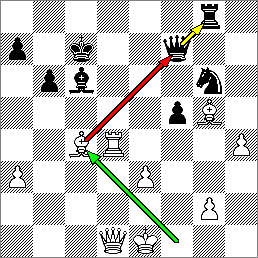
Simple one-move or two-move tactical actions – threats, exchanges of material, and double attacks – can be combined into more complicated combinations, sequences of tactical maneuvers that are often forced from the point of view of one or both players. Theoreticians describe many elementary tactical methods and typical maneuvers; for example, pins, forks, skewers, batteries, discovered attacks (especially discovered checks), zwischenzugs, deflections, decoys, sacrifices, underminings, overloadings, and interferences.
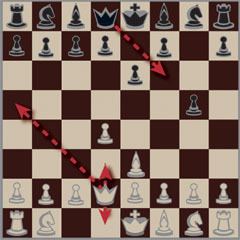
A forced variation that involves a sacrifice and usually results in a tangible gain is called a combination. Brilliant combinations – such as those in the Immortal Game – are considered beautiful and are admired by chess lovers. A common type of chess exercise, aimed at developing players skills, is showing players a position where a decisive combination is available and challenging them to find it.
Fundamentals of strategy
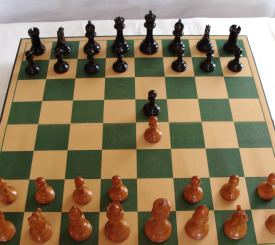
Chess strategy is concerned with evaluation of chess positions and with setting up goals and long-term plans for the future play. During the evaluation, players must take into account numerous factors such as the value of the pieces on the board, control of the center and centralization, the pawn structure, king safety, and the control of key squares or groups of squares (for example, diagonals, open files, and dark or light squares).
The most basic step in evaluating a position is to count the total value of pieces of both sides.The point values used for this purpose are based on experience; usually pawns are considered worth one point, knights and bishops about three points each, rooks about five points (the value difference between a rook and a bishop or knight being known as the exchange), and queens about nine points. The king is more valuable than all of the other pieces combined, since its checkmate loses the game. But in practical terms, in the endgame the king as a fighting piece is generally more powerful than a bishop or knight but less powerful than a rook. These basic values are then modified by other factors like position of the piece (for example, advanced pawns are usually more valuable than those on their initial squares), coordination between pieces (for example, a pair of bishops usually coordinate better than a bishop and a knight), or the type of position (knights are generally better in closed positions with many pawns while bishops are more powerful in open positions).
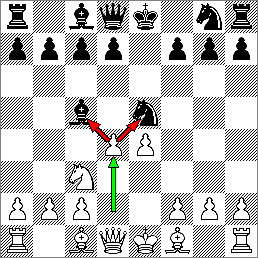
Another important factor in the evaluation of chess positions is the pawn structure (sometimes known as the pawn skeleton), or the configuration of pawns on the chessboard. Since pawns are the least mobile of the chess pieces, the pawn structure is relatively static and largely determines the strategic nature of the position. Weaknesses in the pawn structure, such as isolated, doubled, or backward pawns and holes, once created, are often permanent. Care must therefore be taken to avoid these weaknesses unless they are compensated by another valuable asset (for example, by the possibility of developing an attack).
History
Predecessors-
Chess is believed to have originated in Eastern India, c. 280 – 550 CE,[26] in the Gupta Empire where its early form in the 6th century was known as chatura?ga (Sanskrit: ?????????????), literally four divisions [of the military] – infantry, cavalry, elephants, and chariotry, represented by the pieces that would evolve into the modern pawn, knight, bishop, and rook, respectively. The earliest evidence of chess is found in the neighboring Sassanid Persia around 600, where the game came to be known by the name chatrang. Chatrang is evoked in three epic romances written in Pahlavi (Middle Persian). Chatrang was taken up by the Muslim world after the Islamic conquest of Persia (633–44), where it was then named shatranj, with the pieces largely retaining their Persian names. In Spanish "shatranj" was rendered as ajedrez ("al-shatranj"), in Portuguese as xadrez, and in Greek as ????????? (zatrikion, which comes directly from the Persian chatrang), but in the rest of Europe it was replaced by versions of the Persian sh?h ("king"), which was familiar as an exclamation and became the English words "check" and "chess".[note 3] Murray theorized that Muslim traders came to European seaports with ornamental chess kings as curios before they brought the game of chess.[page needed]
The game reached Western Europe and Russia by at least three routes, the earliest being in the 9th century. By the year 1000 it had spread throughout Europe. Introduced into the Iberian Peninsula by the Moors in the 10th century, it was described in a famous 13th-century manuscript covering shatranj, backgammon, and dice named the Libro de los juegos. Another theory contends that chess arose from the game xiangqi (Chinese chess) or one of its predecessors, although this has been contested.
Origins of the modern game (1000–1850)
Around 1200, the rules of shatranj started to be modified in southern Europe, and around 1475, several major changes made the game essentially as it is known today. These modern rules for the basic moves had been adopted in Italy and Spain.Pawns gained the option of advancing two squares on their first move, while bishops and queens acquired their modern abilities. The queen replaced the earlier vizier chess piece towards the end of the 10th century and by the 15th century had become the most powerful piece; consequently modern chess was referred to as "Queens Chess" or "Mad Queen Chess". These new rules quickly spread throughout western Europe. The rules about stalemate were finalized in the early 19th century. To distinguish it from its predecessors, this version of the rules is sometimes referred to as Western chessor international chess.
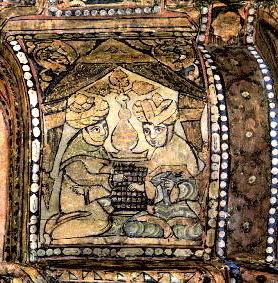
Writings about the theory of how to play chess began to appear in the 15th century. The Repetición de Amores y Arte de Ajedrez (Repetition of Love and the Art of Playing Chess) by Spanish churchman Luis Ramirez de Lucena was published in Salamanca in 1497. Lucena and later masters like Portuguese Pedro Damiano, Italians Giovanni Leonardo Di Bona, Giulio Cesare Polerio and Gioachino Greco, and Spanish bishop Ruy López de Segura developed elements of openings and started to analyze simple endgames.
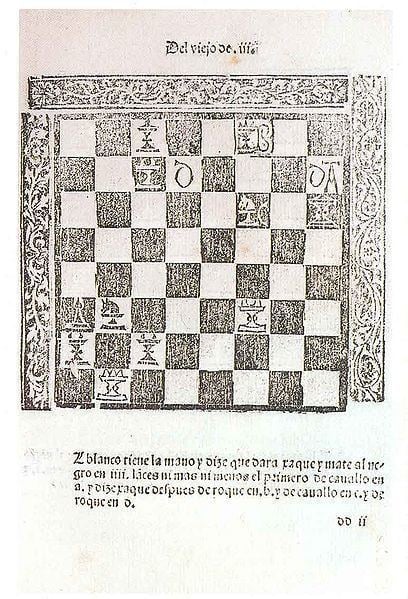
In the 18th century, the center of European chess life moved from the Southern European countries to France. The two most important French masters were François-André Danican Philidor, a musician by profession, who discovered the importance of pawns for chess strategy, and later Louis-Charles Mahé de La Bourdonnais, who won a famous series of matches with the Irish master Alexander McDonnell in 1834.Centers of chess activity in this period were coffee houses in big European cities like Café de la Régence in Paris and Simpsons Divan in London.

Fig : François-André Danican Philidor, 18th-century French chess master
As the 19th century progressed, chess organization developed quickly. Many chess clubs, chess books, and chess journals appeared. There were correspondence matches between cities; for example, the London Chess Club played against the Edinburgh Chess Club in 1824. Chess problems became a regular part of 19th-century newspapers; Bernhard Horwitz, Josef Kling, and Samuel Loyd composed some of the most influential problems. In 1843, von der Lasa published his and Bilguers Handbuch des Schachspiels (Handbook of Chess), the first comprehensive manual of chess theory.
.jpg)